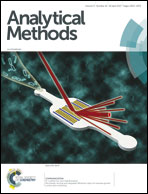Identification of the mango maturity level by the analysis of volatiles based on long optical-path FTIR spectroscopy and a molecular sieve
Abstract
The quality and shelf life of mangoes are closely related to the maturity level. The volatiles of mangoes vary with the maturity level. On the basis of our previous results in evaluating the spoilage stage of fruits, we increased the optical path up to 20 m by using multiple reflection and restrained strong infrared absorption of moisture by using a molecular sieve to identify the maturity level of mangoes. This method could detect infrared absorption peaks of the volatiles emitted from mangoes between the mature green stage to the fully ripe stage. The peaks at 2080–2045 cm−1, 797–787 cm−1, and 760–700 cm−1 existed in the whole maturity period and their intensities gradually increased during the storage. The peaks at 3375–3132 cm−1 only appeared in the fourth and fifth days of the storage period. According to the PLS-DA of infrared absorption peaks in the whole maturity period, the storage period was obviously classified into three stages: the mature green stage (from the first day to the third day), the half ripe stage (from the fourth day to the sixth day), and the fully ripe stage (from the seventh day to the eighth day). The experimental results verified that the method developed in this paper could identify the different maturity levels of mangoes.



 Please wait while we load your content...
Please wait while we load your content...